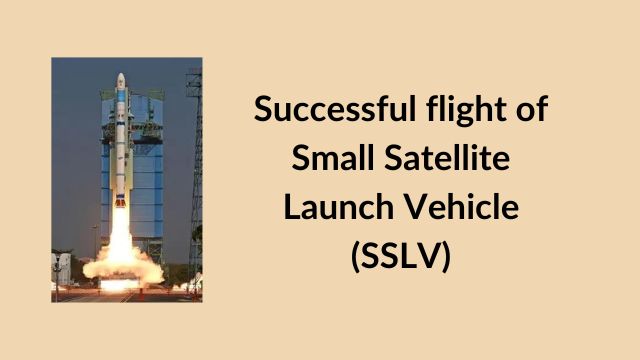The successful flight of a Small Satellite Launch Vehicle (SSLV) by ISRO
Small Satellite Launch Vehicle (SSLV) successfully launched three satellites into their intended orbits. In its second developmental flight, the SSLV-D2 vehicle placed EOS-07, Janus-1 and AzaadiSAT-2 satellites into their intended 450 km circular orbit with an inclination of 37 degrees.
It took off from the first launch pad at Satish Dhawan Space Centre, Sriharikota at 09:18 hours IST and took about 15 minutes to inject the satellites.
SSLV is the new small satellite launch vehicle developed by ISRO to cater the launch of small satellites up to 500 kg to Low Earth Orbits on ‘launch-on-demand’ basis. It is configured with three solid stages 87 t, 7.7 t and 4.5 t respectively. SSLV is a 34 m tall, 2 m diameter vehicle having a lift-off mass of 120 t.
A liquid propulsion-based Velocity Trimming Module (VTM) achieves desired velocity for the insertion of the satellites into the intended orbit. SSLV is capable of launching Mini, Micro, or Nanosatellites (10 to 500 kg mass) to a 500 km orbit. It provides low-cost access to Space, offers low turn-around time, facilitates flexibility in accommodating multiple satellites and demands minimal launch infrastructure.
In its first developmental flight on August 7, 2022, SSLV-D1 had marginally missed to place the satellites. SSLV-D2 implemented the recommendations made by the expert committee that analysed the shortcomings of SSLV-D1 flight.
SSLV-D2 carried EOS-07, a 153.6 kg Earth Observation Satellite realised by ISRO; Janus-1, a technology demonstration satellite weighing 10.2 kg belong ANTARIS, USA; and AzaadiSAT-2, an 8.8 kg satellite realised by Space Kidz India by integrating various scientific payloads developed by 750 girl students across India.
With today’s successful launch India has got a new launch vehicle which was aimed to commercialise the small satellite launches through Industry on demand basis. ISRO looks forward for catering to the increasing global need of launching smaller satellites into Space.




